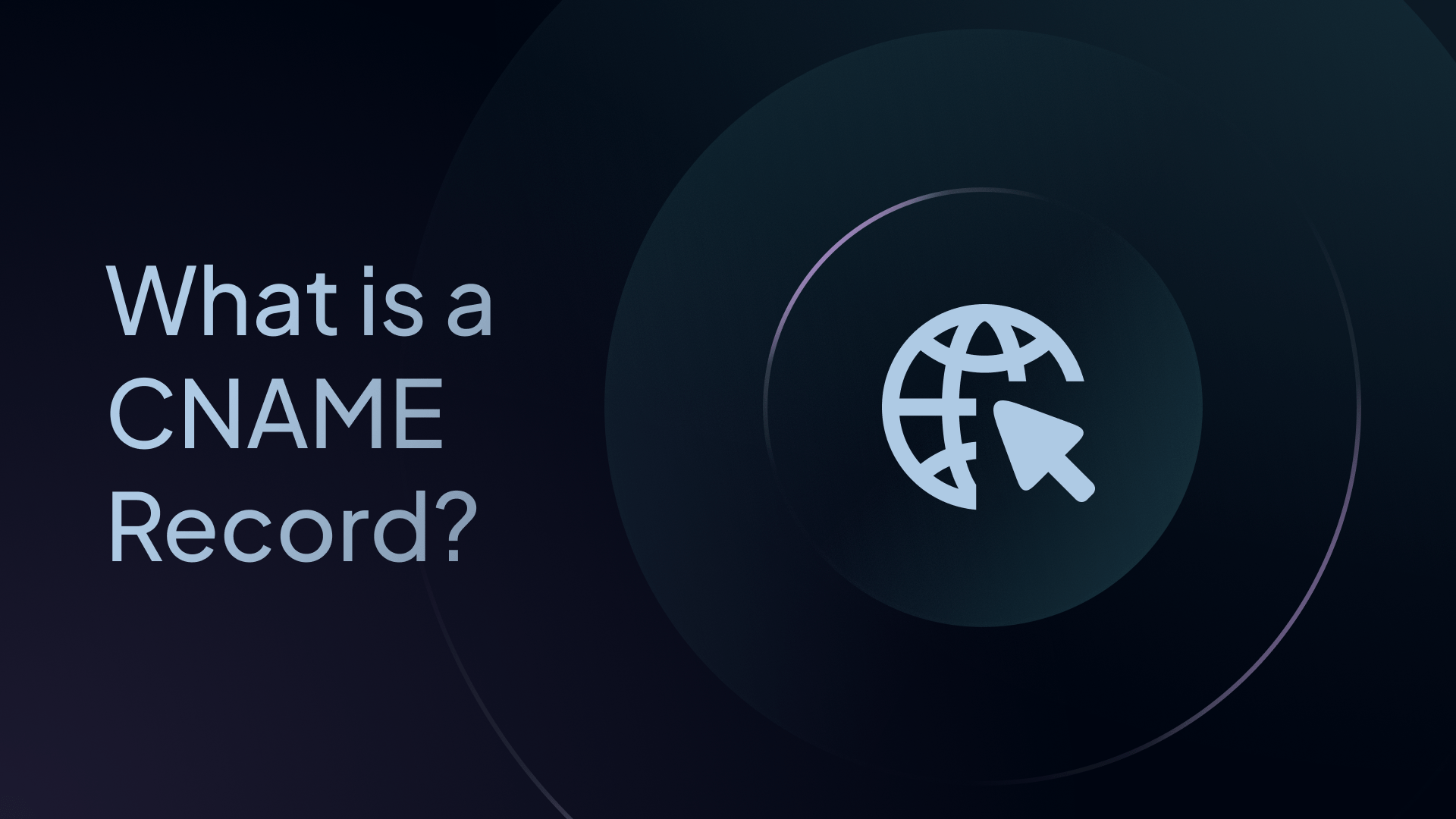What is a CNAME Record?
Master CNAME records with our complete guide. Learn how to set them up, use them effectively, and avoid common DNS management errors.

CNAME records are one of the most useful Domain Name System (DNS) tools, but many website owners don't understand how they work.
Whether you run a small business website or manage enterprise domains, understanding CNAME records will help you manage your DNS better and create a smoother user experience.
This guide explains everything about CNAME records in simple terms, with real examples and practical tips you can use right away.
What is a CNAME Record?
A CNAME record (Canonical Name record) is a type of DNS record that points one domain name to another domain name. Think of it like creating a nickname for your domain – when someone visits the nickname, they automatically get directed to the real website.
For example, you can make a fully qualified domain name (FQDN) www.yourdomain.com point to yourdomain.com using a CNAME record. The person typing www.yourdomain.com will end up at yourdomain.com without knowing anything happened behind the scenes.
www.yourdomain.com).Real-World CNAME Examples
Here are common ways businesses use CNAME records:
- Online stores:
shop.example.com→example-store.shopify.com - Email newsletters:
newsletter.example.com→cname.mailchimp.com - Fast loading:
assets.example.com→cdn.example.com - Blogs:
blog.example.com→example.com
5 Key Benefits to Using CNAME Records
CNAME records serve several key purposes, primarily focused on ease of domain management and ensuring consistent access to your web resources. They include:
✅ 1. Domain Aliasing
CNAME records enable you to create aliases for your domain, which can be helpful when multiple subdomains point to the same target domain or service.
For instance, you can make blog.example.com and store.example.com both point to example.com, ensuring both subdomains resolve to the same server and main domain.
✅ 2. Connect Third-party Services
Many online services require CNAME records. This includes email services, website builders, and content delivery networks (CDNs). For instance, aliasing your domain to the service provider's domain:
cdn.yourdomain.comtocdn.provider.com.
This ensures reliability since when you point your domain to their service using a CNAME, any changes they make happen automatically. The main advantage is that these updates apply instantly to all aliases without extra work on your part.
✅ 3. Simplified DNS Management
Instead of maintaining multiple A records for different subdomains pointing to the same IP address, you can use CNAME records to manage aliases, reducing complexity.
✅ 4. Improve Global Performance
CNAME records help serve content faster worldwide. You can point different subdomains to servers in different locations, so users always connect to the closest server.
✅ 5. Easy Provider Switching
If you need to switch hosting providers, CNAME records make it simple. Change one setting, and all your subdomains automatically point to the new location.
How Do CNAME Records Work?
When someone visits a website with a CNAME record, here's what happens:
- User types address: Someone types
blog.example.comin their browser - Computer asks DNS: The computer asks, "Where does
blog.example.comreally go?" - DNS resolver responds: The DNS system says, "
blog.example.compoints tomain.example.com" - Second lookup: The computer then asks, "What's the IP address of
main.example.com?" - Website loads: The computer gets the real IP address and loads the website
The Technical Process
For technical users, here's what happens during DNS resolution:
- Browser queries DNS for the alias domain (CNAME lookup)
- DNS server returns a CNAME record pointing to the canonical domain
- Browser makes a second query for the canonical domain's A record (A record lookup)
- DNS server returns IP address
- Browser connects to the IP address and loads the site
This process typically adds 10-50 milliseconds to load time, which most users won't notice.
CNAME Records vs. Other DNS Record Types
Understanding different DNS record types helps you choose the right tool:
CNAME vs A Records
A Record:
- Points directly to an IP address (like 192.168.1.1)
- Use for main domains and when you know the exact IP
- Faster resolution (one DNS lookup)
CNAME Record:
- Points to another domain name
- Use for subdomains and services that might change IPs
- Requires two DNS lookups
CNAME vs Alias Records
CNAME Record:
- Cannot exist with other record types on the same domain
- Standard DNS record type
- Works everywhere
Alias Record:
- Can work alongside other records like MX (email)
- Provider-specific feature
- Use for root domains that need email
CNAME vs HTTP Redirects
CNAME Record:
- Works at the DNS level (invisible to users)
- No change in browser address bar
- Faster performance
HTTP Redirect:
- Works at the web server level
- Users see the URL change
- Use when moving content permanently, relocating a subdomain to the root domain, or relocating a set of links from one subdomain to another
Can CNAME Records Point to Other CNAME Records?
Yes, but it's not recommended. Here's why:
Example of CNAME chaining:
blog.example.com→www.example.com(CNAME)www.example.com→example.com(CNAME)example.com→ 192.168.1.1 (A record)
Problems with chaining:
- Requires multiple DNS lookups
- Slows down website loading
- Some DNS servers limit chain length
- Harder to troubleshoot issues
In this scenario, the best practice would be to point both CNAME records blog.example.com and www.example.com directly to example.com (avoiding the chain).
Common CNAME Record Mistakes (And How to Avoid Them)
🚩 Mistake #1: Using CNAME for Root Domains
❌ Wrong: Creating a CNAME for example.com
✅ Right: Only use CNAME for subdomains like www.example.com
💡 Why it matters: Root domains require additional records, such as MX (for email), and CNAME records cannot coexist with other record types.
🚩 Mistake #2: Creating CNAME Chains
❌ Wrong: blog.example.com → www.example.com → example.com
✅ Right: blog.example.com → example.com
💡 Why it matters: Each step in the chain adds loading time and complexity.
🚩 Mistake #3: Mixing CNAME with Other Records
❌ Wrong: Having both CNAME and MX records for the same subdomain
✅ Right: Use CNAME alone or other records alone
💡 Why it matters: DNS rules prohibit CNAME records from coexisting with other record types.
🚩 Mistake #4: Wrong Time To Live (TTL) Settings
❌ Wrong: Using very high TTL values during testing
✅ Right: Use a lower TTL value (like 300 seconds) when making changes
💡 Why it matters: TTL controls how long DNS information is cached. High TTL values make changes take longer to spread across the internet.
🚩 Mistake #5: Unclear Naming
❌ Wrong: Creating CNAMEs like "temp1" or "test2"
✅ Right: Use clear names like "blog" or "shop"
💡 Why it matters: Clear names help you and your team manage DNS records later.
CNAME Record Best Practices
Follow these rules for smooth DNS management:
✅ Keep Good Records
Maintain detailed documentation of all your CNAME records and what they're used for.
✅ Regular Audits
Regularly check your DNS records to identify and correct outdated or misconfigured CNAMEs.
✅ Monitor performance
Track how CNAMEs affect site speed
✅ Use DNSSEC
Use security measures like DNSSEC (DNS Security Extensions) to protect against DNS spoofing and ensure the integrity of your DNS records.
✅ Use Clear Names
To avoid confusion, choose clear and consistent naming conventions for your CNAME records.
Final Thoughts
CNAME records are powerful tools for managing multiple domains and connecting third-party services. They make DNS management easier and give you flexibility when building your online presence.
By following the best practices in this guide, you'll use CNAME records effectively and avoid common mistakes that can slow down your website or break functionality.

Frequently Asked Questions (FAQs)
What is a CNAME record in simple terms?
A CNAME record is like a nickname for your website address. It tells computers that when someone visits one web address, they should go to a different address instead.
Can I use a CNAME record for my main domain?
No, you cannot use a CNAME record for your root domain (like example.com). You can only use it for subdomains (like www.example.com or blog.example.com).
What's the difference between a CNAME and an A record?
An A record points directly to a server's IP address (like a street address). A CNAME record points to another domain name (like saying "go to wherever John lives"). A records are faster but less flexible than CNAME records.
How long do CNAME changes take to work?
CNAME record changes usually take 1-24 hours to work everywhere, but can take up to 48 hours in some cases. This delay is called DNS propagation. You can speed this up by using lower TTL values.
Can CNAME records slow down my website?
CNAME records add a tiny delay (usually under 50 milliseconds) because your computer has to make an extra DNS lookup. For most websites, this isn't noticeable to users.
Why can't I use CNAME with email records?
DNS rules don't allow CNAME records to exist alongside other record types like MX (email) records. It's an either/or situation.
How many CNAME records can I create?
Most DNS providers don't limit CNAME records, but too many can make management complicated. Focus on creating only the CNAME records you actually need.
Do CNAME records affect SEO?
CNAME records themselves don't hurt SEO, but they can slightly slow page loading if not set up properly. Use them wisely.
What happens if I delete a CNAME record?
If you delete a CNAME record, the subdomain will stop working and visitors will see an error page. Make sure you have a backup plan before removing any DNS records.

